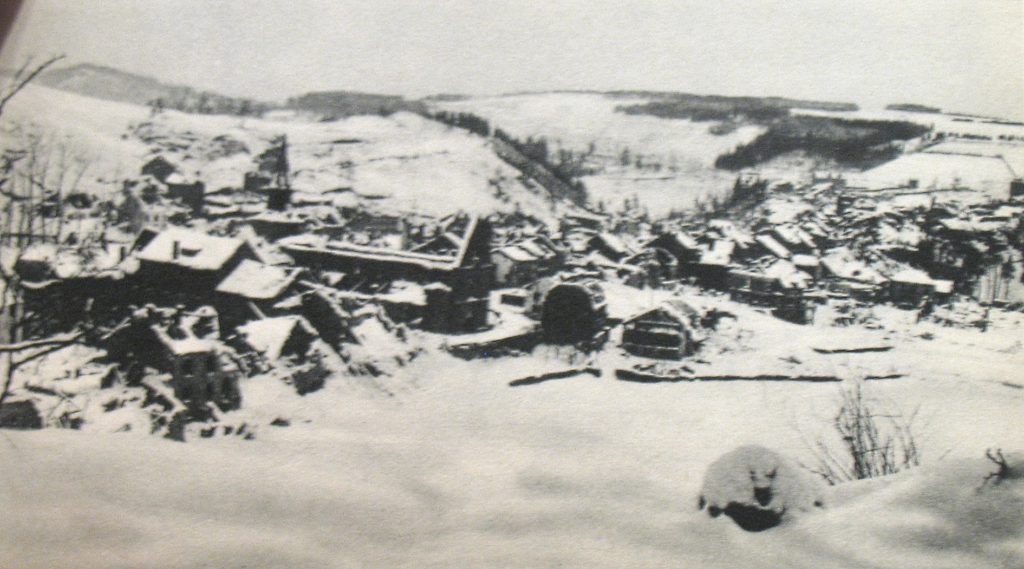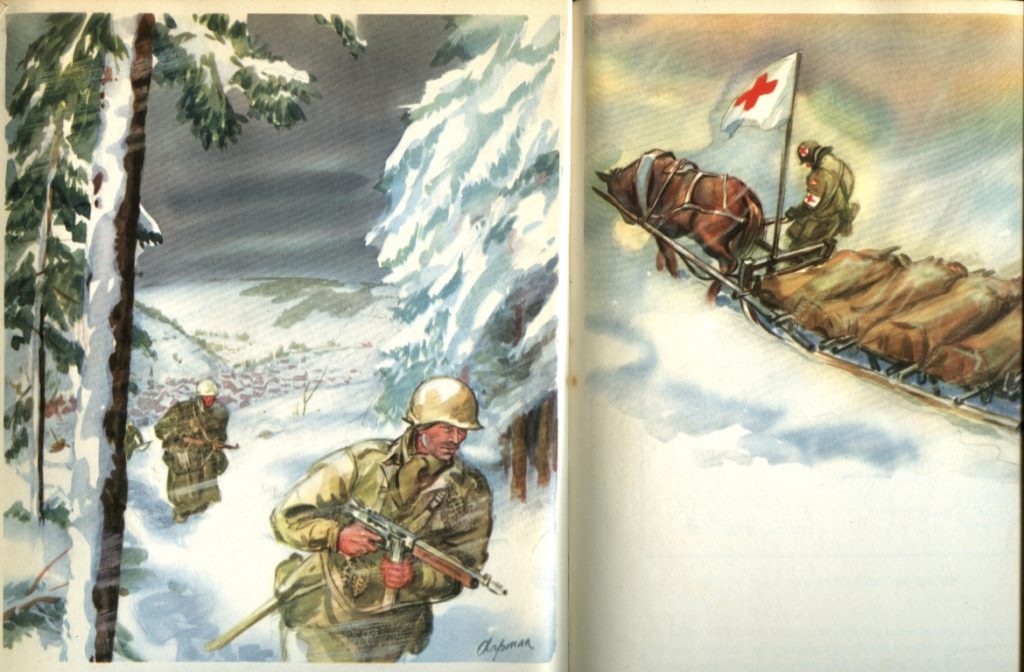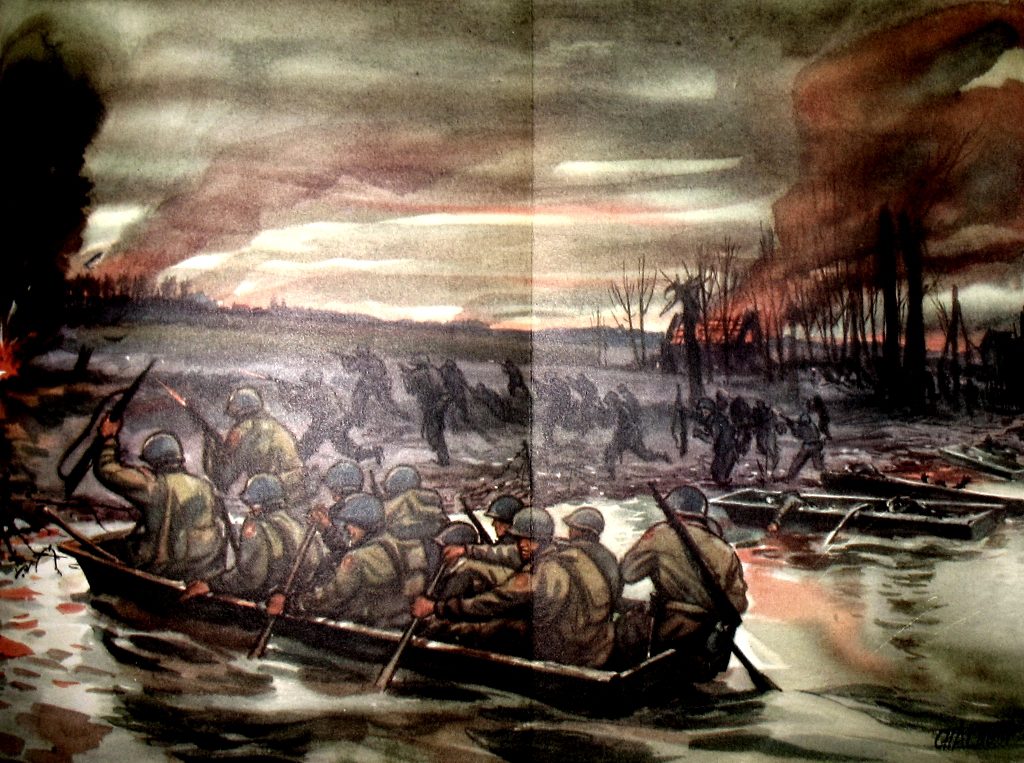Today is my Dad’s birthday, a date he shares with Abraham Lincoln and Charles Darwin! Every winter, when I travel around Central New York, I think about my Dad’s experiences in World War II. He was in the Battle of the Bulge, and when the temperatures drop, I often wonder where exactly he was on the same day in 1945.
His 84th Infantry Division helped close the Battle of the Bulge, and years later Dad annotated a map showing where he and his guys took a hill north of Houffalize on 15 January 1945. This is the same date as shown on a V Mail sheet he mailed home from Belgium.

Map 9 in “The 84th Infantry Division in the Battle of Germany, November 1944 – May 1945” by Lt. Theodore Draper. Maps and drawings by Sgt. Walter H. Chapman. Viking Press, NY, 1946.
On 30 January 1945, he wrote, “the Ardennes are so much like our own hills in Madison County, that it frequently makes me homesick just to look at them.”

Photo showing Houffalize, near the end of January, 1945, from “The 84th Infantry Division in the Battle of Germany, November 1944 – May 1945” by Lt. Theodore Draper. Maps and drawings by Sgt. Walter H. Chapman. Viking Press, NY, 1946.
After the Bulge, the 84th took 5 days off, and then went back to fighting on the 6th day. 333rd Infantry was part of the attack to secure Beho, Gouvy, and Ourthe, necessary to stage the crossing of the Roer River (Germans spell it “Rur”). These few days were difficult, even if they have never received much scrutiny in the overall scheme of things.
 Lt. Draper wrote that “ . . . the battles were every bit as important as any other battles anywhere. They were just as hard, just as bitter. Men died, dug for cover, ducked 88’s, bandaged up buddies if they could, the same way. It was still cold. The snow was 3 or 4 feet deep. Vehicles still could not get off the roads without staying off permanently . . . little objectives which nobody notices that have to be bought with blood yard by yard.”
Lt. Draper wrote that “ . . . the battles were every bit as important as any other battles anywhere. They were just as hard, just as bitter. Men died, dug for cover, ducked 88’s, bandaged up buddies if they could, the same way. It was still cold. The snow was 3 or 4 feet deep. Vehicles still could not get off the roads without staying off permanently . . . little objectives which nobody notices that have to be bought with blood yard by yard.”
 Key now was to cross the Rhine and then go on to Berlin. However, before the Ninth Army could get to the Rhine, they had to cross the Roer River, a fast moving, white water river with several dams still controlled by German forces. On February 3rd, Dad’s 84th assumed responsibility for the river front from Linnich to Himmerich. The Roer would be relatively easy to cross at several natural fords, but after German forces partially destroyed and opened the dams upstream on February 10th, the water rose to a high of 11’ 1”, and remained at 10’ high for most of the month of February.
Key now was to cross the Rhine and then go on to Berlin. However, before the Ninth Army could get to the Rhine, they had to cross the Roer River, a fast moving, white water river with several dams still controlled by German forces. On February 3rd, Dad’s 84th assumed responsibility for the river front from Linnich to Himmerich. The Roer would be relatively easy to cross at several natural fords, but after German forces partially destroyed and opened the dams upstream on February 10th, the water rose to a high of 11’ 1”, and remained at 10’ high for most of the month of February.
Overruling his generals, Hitler ordered his army to hold the line at the Roer, to prevent the Allied forces reaching the larger, wider Rhine to the East. Germans held high ground along the Eastern side of the Roer, and focused their artillery on the Americans, English, and Canadians. During the flood, the Allied forces, planned and trained for almost three weeks for Operation Grenade, in anticipation of crossing the Roer. This is where Dad turned 21 years.
 On the 23rd, 2 am, (after engineers prepared foot bridges and boats and sent guides across) the 334th 1st battalion was first to cross (with Dad’s 333rd giving cover fire from behind) one squad per boat, commanded by an engineer. Each boat was under constant fire and shelling as they crossed. There was intense Allied fire and shelling for a full 45 minutes prior to crossing.
On the 23rd, 2 am, (after engineers prepared foot bridges and boats and sent guides across) the 334th 1st battalion was first to cross (with Dad’s 333rd giving cover fire from behind) one squad per boat, commanded by an engineer. Each boat was under constant fire and shelling as they crossed. There was intense Allied fire and shelling for a full 45 minutes prior to crossing.
Lt. Draper noted that “A total of 8,400 rounds of field artillery ammunition was expended. The 557th Anti-Aircraft Artillery Battalion fired a total of 272,736 rounds of .50 caliber ammunition, wearing out 125 barrels. The crews of the 771st Tank Battalion supported the crossing and the follow-up for about 15 hours, firing so much ammunition that they often became sick from the fumes in the tanks and had to get out to relieve their nausea. A total of 120,000 rounds were fired by 24 multiple-mount .50 caliber machine guns, and 4,000 rounds were sent off by 24 60 mm. mortars in 15 minutes.“


